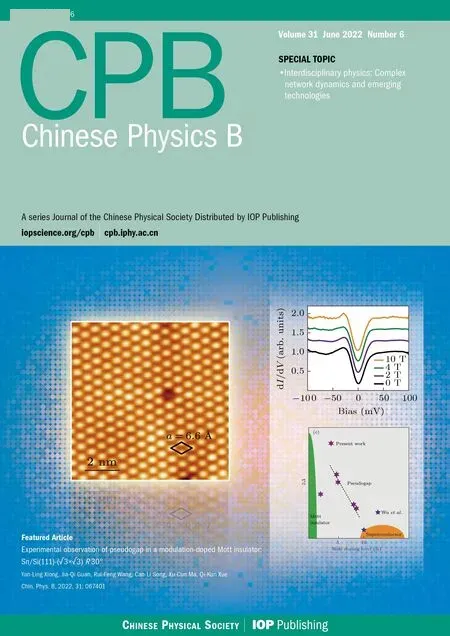Heralded path-entangled NOON states generation from a reconfigurable photonic chip
Xinyao Yu(于馨瑤), Pingyu Zhu(朱枰諭), Yang Wang(王洋), Miaomiao Yu(余苗苗), Chao Wu(吳超),Shichuan Xue(薛詩川), Qilin Zheng(鄭騎林), Yingwen Liu(劉英文), Junjie Wu(吳俊杰), and Ping Xu(徐平)
Institute for Quantum Information&State Key Laboratory of High Performance Computing,College of Computer Science and Technology,National University of Defense Technology,Changsha 410073,China
Keywords: path-entangled NOON state,phase measurement
1. Introduction
Quantum entanglement,[1]the distinctive feature of quantum systems,plays a crucial role in quantum information processing and lies at the heart of the emerging quantum technologies. In particular, multi-photon maximally entangled states,[2,3]so-called NOON states, have attracted much attention for their great importance in quantum metrology and lithography. The NOON state, denoted as|N::0〉, takes the form

Numerous studies have been done on the generation of NOON states, via both bulk optics and integrated optics. A prominent example is the generation of the two-photon NOON state.[8,9]By feeding two single photons into the inputs of a balanced beam splitter,a NOON state withN=2 can be easily and deterministically obtained at the outputs for the bunching effect of photons, which is also known as the Hong–Ou–Mandel effect. However, whenN >2, generating NOON states is not straightforward. So far, there have been three main ideas to obtain the NOON state whenN >2. The first is harnessing multi-photon interference of classical coherent states and quantum down-converted states;[10,11]by adjusting their ratio over different inherently scalable approaches,high-NOON states with up toN= 5 have been generated. The second is a bulk optic-based linear optical scheme: by manipulating polarized-encoded photons,[12–15]realistic experimental methods for generating three-and four-photon NOON states have been proposed. The third are schemes on integrated photonic circuits. Recently, on-chip schemes for generating two- and even multi-mode NOON states have been proposed.[17–20]Among these works, on the one hand, some of them are based on anN-fold photon coincidence detection,that is,via post-selection;[15,16]the required NOON state was separated from the undesired components at the final detection stage, leading to no further applications performed. On the other hand, bulk optical performance is less than satisfactory when it comes to spatial scalability and phase stability. However,the lack of deterministic single-photon sources[17–19]required by some existing on-chip schemes brings makes some experimental demonstrations very difficult. In addition,some of them require off-chip quantum light sources and bulk optical elements, which hinder their portable and robust working fashion.[20]
This paper proposes a fully integrated scheme to generate NOON states encoded in path-mode based on heralding on a reconfigurable photonic chip. In our scheme, we take advantage of the nature of photons in pairs,and utilize the high-order terms of basic two-photon sources; then, on the same chip,quantum interference take its role in the cascaded photonic circuits to enable three-photon and four-photon NOON state generation in a heralded fashion. We concretely show the configuration forN=3 andN=4,which is implementable within current technical conditions. Consisting of on-chip quantum sources and reconfigurable photonic circuits, our proposal is stable and user-friendly.Our scheme involves the explicit generation of the required NOON quantum state, which can be applied to allow for further quantum information processing such as supersensitive and super-resolved single parameter estimation and sensing.
2. Theory and scheme
At the very beginning, we will briefly introduce the key elements supporting the scheme and the main processes occurring on our device. Photon pairs can be produced via a nonlinear process on our photonic chip.By injecting two pump lights with different frequencies into a spiraled waveguide or microring resonator(MRR),the degenerate spontaneous four-wave mixing (SFWM) process occurs, producing pairs of photons with the same frequency; i.e., indistinguishable photon pairs are obtained, which is the key to the NOON states, as shown in Figs. 1(a) and 1(b). Here, we prefer to use micro-rings coupled by a single or dual asymmetric Mach–Zehnder interferometer(AMZI),which ensures spectral purity for generating bright indistinguishable photon pairs;namely,the only the two-photon sources differ or are encoded in path while all the other degrees of freedom are kept identical. Specifically,compared with the spiraled waveguide, via its elaborate design,the AMZI-coupled micro-ring can obtain high spectral purity photons without decreasing the photon rates.[22–25]Next, by combining an unbiased beam splitter(BS),i.e.,the symmetric 50:50 BS and two degenerate SFWM-based collinear sources(see Fig.1(c)),our two-photon state,which also represents the path-entangled NOON state withN=2, is obtained through the formula




It has been shown that the MZI with such structure can realize a BS with variable reflectivity;[21]therefore, by adjusting the phase shifterθ,one can split photon beams in an arbitrary ratio to the two paths.
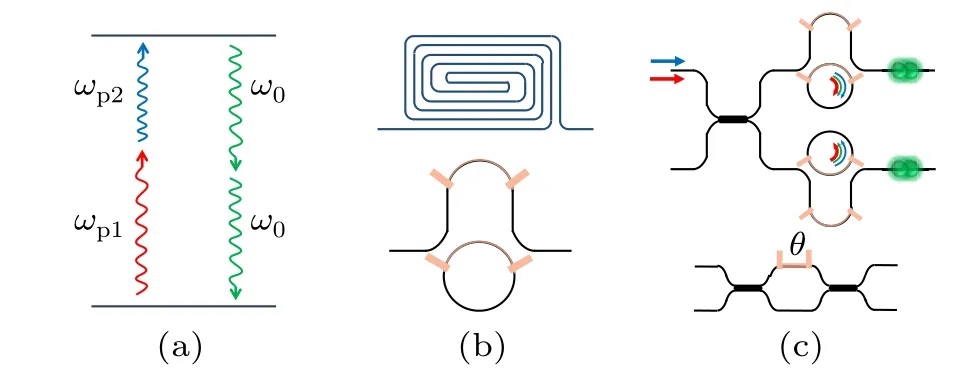
Fig.1. On-chip key components and processes. (a)Degenerate SFWM process for generating photon pairs with same frequency. (b) Spiraled waveguide(top)and micro-ring resonator(bottom)for on-chip SFWM process. (c)Two-photon NOON state source(top),and the Mach–Zehnder interferometer(bottom).
Now we will turn to our device. Our photonic chip includes three functional parts, as shown in Fig. 2: quantum source, path-entangled NOON-state generation and detection and verification. In the quantum source part, pump lasers are divided equally between the two paths,and degenerate SFWM occurs in two MRRs, producing path-encoded-entangled but frequency uncorrelated photon pairs. Next, the photon pairs transit into the NOON-state generation part to obtain a certain photon-number NOON state. Finally,by observing the corresponding triggered events from the detectors shown in the third part,heralded path-entangled NOON states are generated.
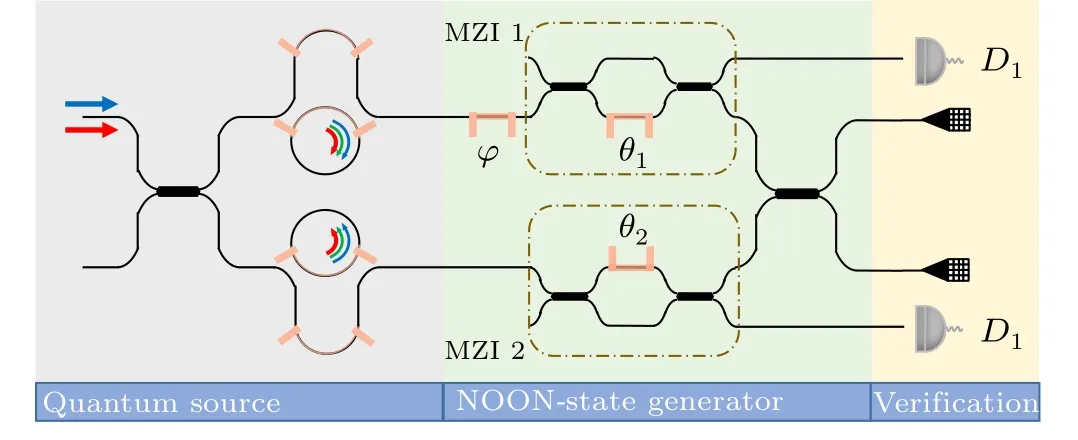
Fig.2.The universal scheme for generation of on-chip maximal multi-photon path-entangled states.
In our three-photon NOON states generating process,we specify the second-order term to be the quantum source. The superposition state of four-photon terms after two SFWM processes can be expressed by

Considering that the creation operator will lead to extra coefficients, we append a normalization factor 1/2; therefore the initial state for generating three-photon NOON states takes the form of
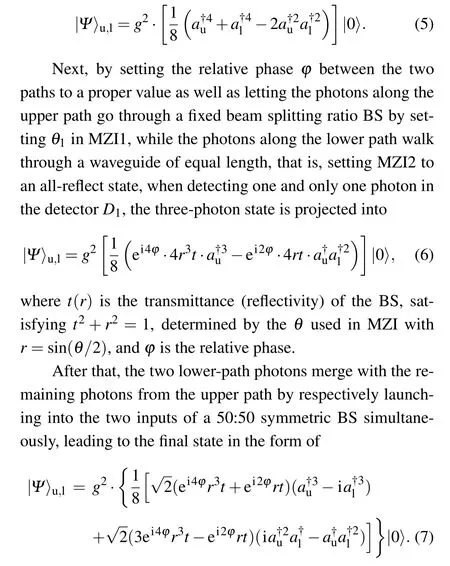
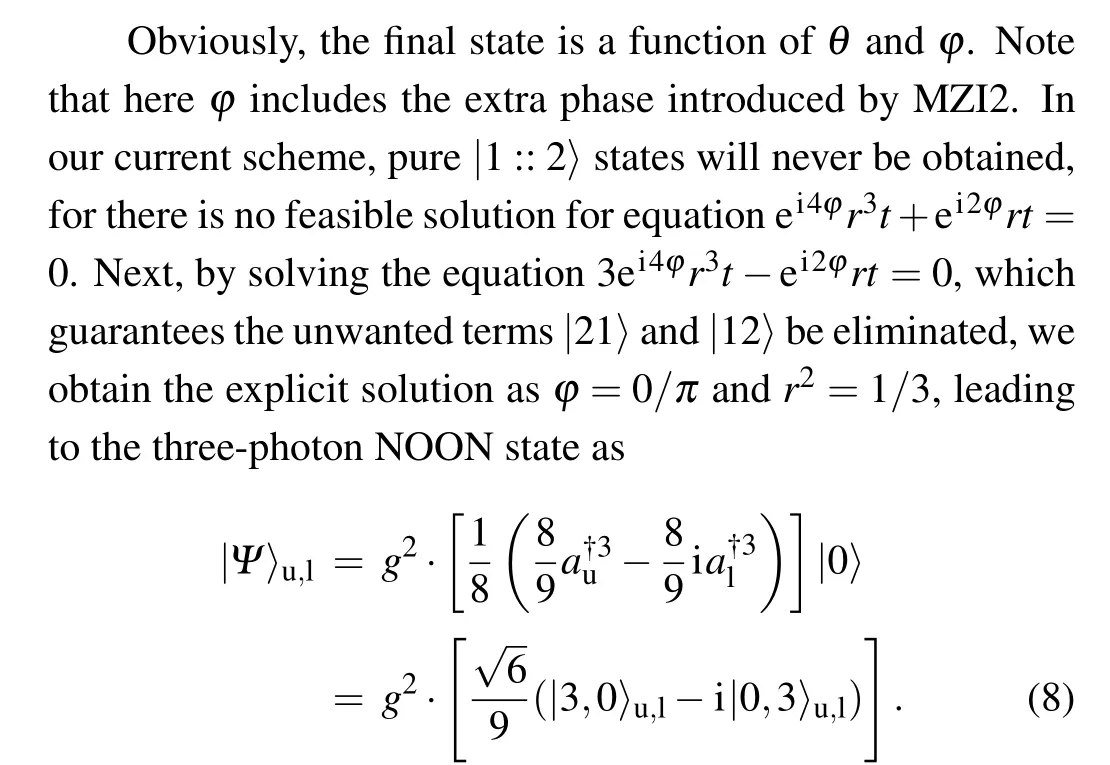
The generation efficiency is defined as the square of the modulo probability amplitude. Therefore,the generation efficiency of our scheme is 4/27. Additionally, the overall generation efficiency is (4/27)g2by taking the factorginto account,i.e. we obtain a three-photon path-entangled state with the probability of(4/27)g2.

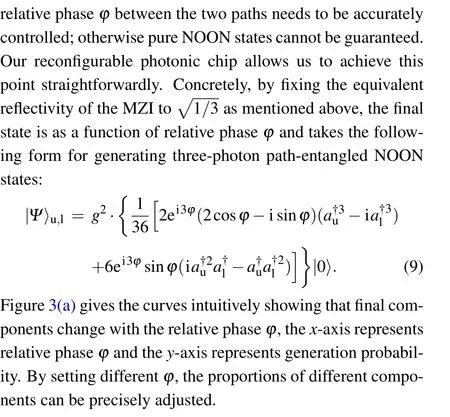
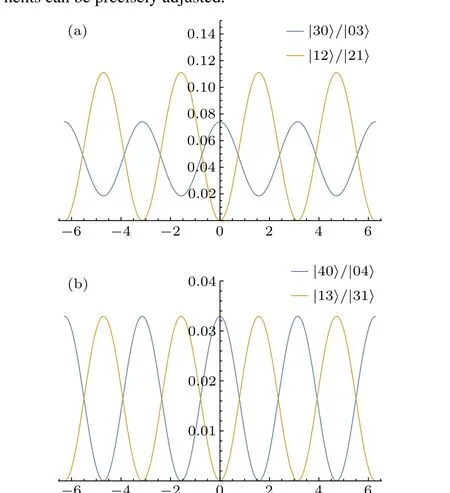
Fig.3. Curves for final states from schemes for generating(a)three-photon and (b) four-photon path-entangled NOON states. The x-coordinate represents the relative phase φ,and y-coordinate represents the generation probability.
Similarly, after two SFWM processes, the superposition state of six-photon terms can be expressed as follows(also appended a normalization factor as 1/6):

In the NOON-state generation stage,firstly,as before,we introduce a proper relative phaseφbetween the two paths,and then the photons on both paths separately pass through an MZI,used as a BS with fixed beam splitting ratio. The processes on the two paths may be performed simultaneously or in steps. Finally,by merging the upper and the lower path mode photons via a balanced BS, under the condition of detecting precisely one and only one single photon at detectors in each of these two heralding modes,we obtain the four-photon pathentangled NOON state from the outputs.

Following the procedure above,we set both AMZIs to the optimum beam splitting ratio and explore how the components of our final states from the four-photon NOON state generator vary with the relative phaseφ.
After some simple calculation and derivation, the final state evolves into the form of An intuitive curve is shown in Fig.3(b).

Obviously, by tuning the relative phaseφto zero orπ,pure four-photon path-entangled NOON states will be obtained. In the following,we will show the evolution process in detail.
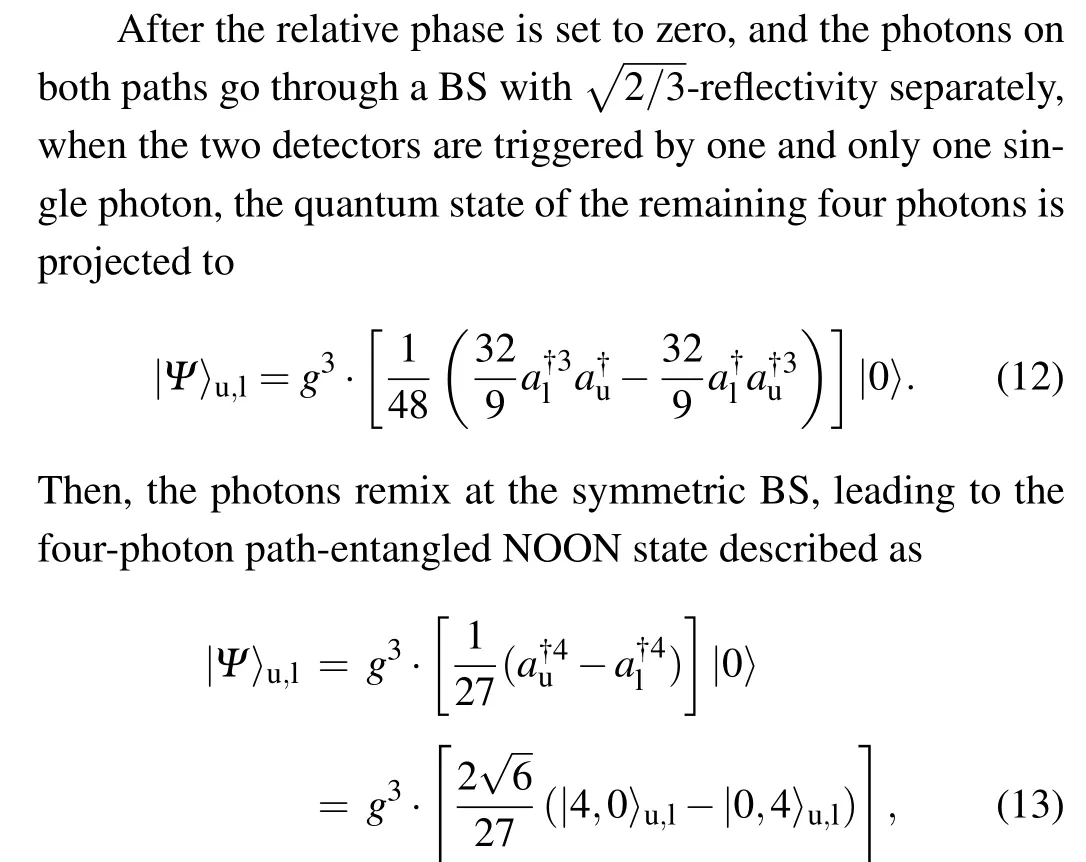
with an overall generation efficiency of(16/243)g3.
From Eq. (11) we also find that by setting the relative phaseφto an appropriate value such asπ/2,pure states in the form of|1::3〉will be generated with the same overall generation efficiency as|4::0〉states in theory, which is proven to be more robust in the presence of losses.[26]
So far,we have introduced our scheme in detail.Actually,the scheme shown in Fig.2 is a universal scheme for generating two-, three-, and four-photon NOON states. As listed in Table 1, by reconfiguring the relative phaseφand the MZIs to the all-reflect state or BSs with appropriate reflectivities,as long as the single-photon detected event occurs at the corresponding detector, the success of heralded maximal multiphoton path-entangled state generation is certified.

Table 1. Parameters and efficiency in generating different states via the chip shown in Fig.2.
3. Discussion and conclusion
We have theoretically demonstrated a compact scheme for generating two-, three-, and four-photon NOON states on our reconfigurable photonic chip. Compared with the previous work,[20]our structure is fully integrated, including SFWM photon sources and path-entangled NOON state generators composed of a series of linear optical elements such as MZIs. Our proposal is of higher portability, integration and practicability with no extra requirements of off-chip bulk nonlinear crystals and optical elements. Furthermore,the two-photon sources on our chip have a higher spectral purity which ensures higher visibility of quantum interference for the phase sensing measurements. This scheme is feasible since all of the above-mentioned elements are demonstrated with high performance. The AMZI-coupled micro-rings have been wildly studied in previous works by our group and other groups,[22–25]and high spectral purity is experimentally achieved.[22]For the liner optical circuits composed by MZIs,a large number of studies have proved them to be of high precision and reconfigurability.[27,28]Considering the generation rate of this heralded three-photon or four-photon NOON state,which actually provides four-photon or six-photon probability,a high generation rate is expected since the on-chip multiphoton quantum states with up to eight photons have been demonstrated.[29–31]
As forN ≥5, the circumstances and outcomes of interference are more diverse while such a two-mode interference beam splitter has limited capacity for eliminating unwanted terms. In spite of this, adding quantum sources and regarding the generator as a universal linear optical network may be a potential method to achieve high-NOON states. As photon numbers increase,although the generation efficiency decrease,our generation efficiency is still productive. Furthermore, by harnessing our previous work,[22–24]the factorgcan be optimized for higher overall generation efficiency. In summary,our heralded proposal is a new method for generating maximal multi-photon path-entangled states and has a wide range of applications in the field of quantum metrology and lithography,especially highly integrated,miniaturized and precision measurements as well as quantum sensing.
Acknowledgments
Project supported by the National Basic Research Program of China (Grant No. 2017YFA0303700) and the Open Funds from the State Key Laboratory of High Performance Computing of China (HPCL, National University of Defense Technology).
- Chinese Physics B的其它文章
- Switchable terahertz polarization converter based on VO2 metamaterial
- Data-driven parity-time-symmetric vector rogue wave solutions of multi-component nonlinear Schr¨odinger equation
- Neutron activation cross section data library
- Multi-phase field simulation of competitive grain growth for directional solidification
- A novel similarity measure for mining missing links in long-path networks
- Effects of electrical stress on the characteristics and defect behaviors in GaN-based near-ultraviolet light emitting diodes

